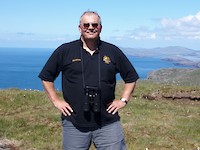About twice a year I travel to speak about Scottish islands on cruise ships. I never tire of sharing Shetland, the Outer Hebrides, Mull – or Orkney – with folk who might be seeing them for the first time.
I arrived back from a trip to Faroe in October, via Shetland, calling into Kirkwall for the day on the way to Tilbury. I was up early as we sailed down the east side of Orkney into Hatston. It was dark but I saw first North Ronaldsay lighthouse, then Start Point in Sanday and the light on Auskerry before, finally, all the winking buoys, pier lights and street lights of Kirkwall. I was sailing home.
As a new islander the sensation of coming home by sea is still quite new, having been used to nothing more romantic than motorway signs to tell me if I’m nearly there yet. It occurred to me that travellers from these islands must always have been deeply moved by their first sight of land on the way home.

At the end of the 1960 film “Sink the Bismarck” Michael Hordern, playing the part of Admiral Sir John Tovey on board HMS King George V, gave the order: “Yeoman, make to the Admiralty, Bismarck is sunk, we are returning to Scapa Flow”. The relief was acted in the film but we can only imagine the actual relief felt by everyone on board (in 1941) when Duncansby and Pentland Skerries lights (switched on briefly for them) were spotted. The swell they had been feeling for days would suddenly drop on passing Stroma and Swona, a password was given to allow safe passage under the guns at Hoxa and Flotta. They proceeded to anchorage in the Flow and heard the chain rattle out, engines stop then silence. The same would have been felt by Admiral Jellicoe’s men on returning from the Battle of Jutland in 1916.
The Hudson’s Bay Company had a big presence in Stromness too. Their ships had little to guide them home across the Atlantic. They could measure latitude and longitude – if they could see the sun – but right in their path lay Sule Skerry with associated stacks and reefs. A lighthouse was established there in 1895 and three years later on Westray’s Noup Head. These must have come as a huge boon to navigators and watchers from crows’ nests when approaching Orkney. So many boats were lost on Sule Skerry that fishermen visited specifically to salvage what they could. Even after the light was established there continued to be losses, right up to 1968.

For the purposes of this story I had hoped to find that Captain Cook returned from one or other of his voyages via Stromness but it was not to be. Cook was murdered in Hawaii in 1799. His ships, Resolution and Discovery, however, did arrive in Stromness, on their way home, to collect fresh water from Login’s well in 1780.
The men of Resolution and Discovery sold Captain Cook’s dinner service, to buy provisions and a lovely display of plates can be viewed at Skaill House, alongside the table which is laid for an elegant dinner. It is likely Cook’s senior officers were entertained there, whilst other ranks explored the ale houses and taverns of Stromness.

Orkney was a staging post for all manner of other ships sailing to the north-west during earlier centuries. Explorers, whalers and fishing boats often called in for fresh water, supplies and recruits. Sir John Franklin’s ill-fated expedition sailed from Stromness, as did his would-be rescuer, Orkney’s very own Dr John Rae. Franklin sailed up the east coast of England and Scotland, from his starting point in The Thames, and made landfall in Stromness, Orkney. Michael Palin’s new account of Franklin’s flagship – Erebus – gives the following excerpt from a letter by Lieutenant Fairholme:
I never saw anything more lovely than the scene last night, as we ran through the narrow passages among these little islands. In themselves there is nothing of the beautiful, as they are perfectly bare, but there was such a sky and such a summit on such a glass-like sea that it was quite worthy of the Gulf of Smyrna.
In 2014 the remains of Erebus, were found using sophisticated sonar buoys. She lies, not too deep, to the west of King William Island, and still remarkably intact for a wooden sailing vessel having lain on the seabed for over 160 years. The full outline and shape are clear. On the first dive canons and the ship’s bell were found. Ownership of the wrecks (HMS Terror has also been found) has been passed to The Canadian Government but who would bet against a touring exhibition of finds arriving at Stromness Museum sometime? Franklin did not make it home but the remains of his expedition may yet sail in through Hoy Sound to Hamnavoe – the Haven Bay.
 Richard contributes regularly to Scottish Islands Explorer magazine and his first book: 'Scotland’s Islands – A Special Kind of Freedom' was published in 2014. His new book 'Orkney – A Special Place' is available from all the usual outlets now.
Richard contributes regularly to Scottish Islands Explorer magazine and his first book: 'Scotland’s Islands – A Special Kind of Freedom' was published in 2014. His new book 'Orkney – A Special Place' is available from all the usual outlets now.
The Digital Orkney project has been part financed by the Scottish Government and the European Community Orkney LEADER 2014-2020